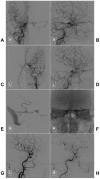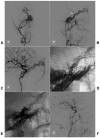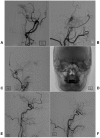Endovascular treatment of the cavernous sinus dural arteriovenous fistula: current status and considerations
- PMID: 32410842
- PMCID: PMC7211155
- DOI: 10.7150/ijms.45210
Endovascular treatment of the cavernous sinus dural arteriovenous fistula: current status and considerations
Abstract
A cavernous sinus dural arteriovenous fistula (CS-DAVF) is an abnormal arteriovenous communication involving the dura mater within or near the CS wall. The dural arteries from the internal carotid artery and external carotid artery supply the CS-DAVF, and the superior ophthalmic vein (SOV) and inferior petrous sinus (IPS) are frequent venous drainers. In CS-DAVF cases, high-risk lesions require treatment. Endovascular treatment (EVT) has been the first-line option for CS-DAVFs. To our knowledge, a review of the EVT of CS-DAVFs is lacking. Therefore, in this paper, we review the available literature on this issue. In addition, some illustrative cases are also provided to more concisely expound the EVT of CS-DAVFs. According to the recent literature, transvenous embolization via the IPS is considered the most effective method for EVT of CS-DAVFs. In addition, the transorbital approach is another reasonable choice. Other venous approaches can also be tried. Because of the low cure rate, transarterial embolization for CS-DAVFs is limited to only highly selected patients. In the EVT of CS-DAVFs, various agents have been used, including coil, Onyx, and n-butyl cyanoacrylate, with coil being the preferred one. In addition, when EVT cannot obliterate the CS-DAVF, stereotactic radiotherapy may be considered. In general, despite various complications, EVT is a feasible and effective method to manage CS-DAVFs by way of various access routes and can yield a good prognosis.
Keywords: cavernous sinus; dural arteriovenous fistula; endovascular treatment; review.
© The author(s).
Conflict of interest statement
Competing Interests: The authors have declared that no competing interest exists.
Figures




References
-
- Hiramatsu M, Sugiu K, Hishikawa T, Nishihiro S, Kidani N, Takahashi Y, Results of 1940 embolizations for dural arteriovenous fistulas: Japanese Registry of Neuroendovascular Therapy (JR-NET3) J Neurosurg. 2019. pp. 1–8. - PubMed
-
- Zyck S, Gould GC. Fistula, Dural Arteriovenous. StatPearls. Treasure Island (FL) 2019.
-
- Fang B, Qian C, Yu J, Xu L, Jiang D, Xu J. et al. Transarterial Embolization of Cavernous Sinus Dural Arteriovenous Fistulas with Ipsilateral Inferior Petrosal Sinus Occlusion via the Ascending Pharyngeal Artery. World Neurosurg. 2018;117:e603–e11. - PubMed
-
- Phan K, Xu J, Leung V, Teng I, Sheik-Ali S, Maharaj M. et al. Orbital Approaches for Treatment of Carotid Cavernous Fistulas: A Systematic Review. World Neurosurg. 2016;96:243–51. - PubMed
Publication types
MeSH terms
LinkOut - more resources
Full Text Sources

